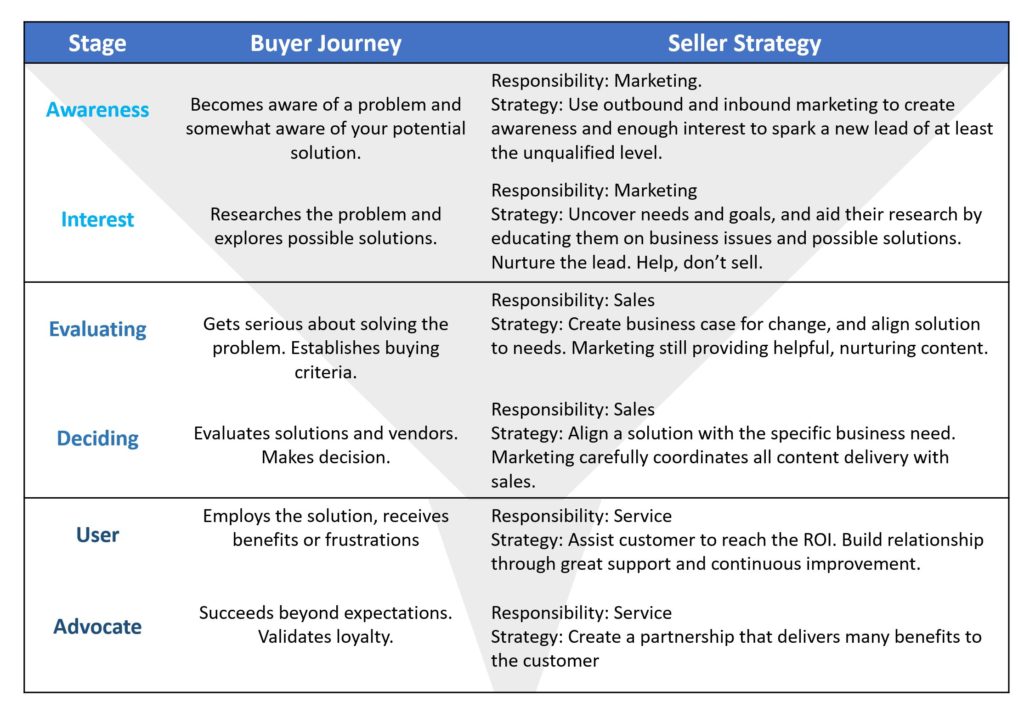[Part 2 of 3]
In Part 1 of this series, I introduced the three-funnel segment approach for designing your commercial engine. The commercial engine is the company’s system for obtaining leads, selling, and serving the customer. Your commercial engine funnel consists of the marketing funnel segment, sales funnel segment, and customer funnel segment. But what about the buyer journey?
How is the buyer journey defined in high dollar sales, and how does it line up to the three funnel segments?
Note: This blog is part 2 of a three-part blog series: Designing your Commercial Engine for Success
Part 1: Understanding the 3 Funnel Segments of your Commercial Engine
Part 2: Mapping the Buyer Journey to your Customer Engine Funnel
Part 3: Aligning Lead Management, the Buyer Journey, and 3 Funnels
Mapping your prospects’ buyer journey to your Commercial Engine Funnel keeps you organized and enables you to provide the most effective interaction at the right time. Buyer needs change significantly during their journey from lead to loyal and so must your content and interactions – if you hope to accompany them.
Responsibility is the key
The key is to assign responsibility to the appropriate group as buyer needs change. The departmental structure of your commercial team (covering the marketing, selling, and supporting of your offerings) should be designed to match the buyer journey.
In high dollar B2B sales, the buyer journey comprises of six stages:
Awareness & Interest – where buyers understand their problem and have begun thinking about potential solutions.
Evaluating & Deciding – where buyers are considering entering or are already in the buying cycle.
User & Advocate – where buyers are your customers.
These six buyer journey stages line up with the three segments of your commercial engine funnel.
Buyer Journey Stages
As mentioned in Part 1 blog, the marketing team manages the marketing funnel segment, the sales team handles the sales funnel segment, and the service team is responsible for the customer funnel segment. The needs of the buyer are very different in each funnel segment and designing the responsibilities of your commercial departments to match those needs improves your customer engine efficiency.
Note: The Curiosity Stage
One stage is outside of your funnel segments – the curiosity stage. Here, the prospect has not provided you with any contact information. They might be consuming some free content from the internet or have seen an offering like yours at a tradeshow, but at this point they are not a lead and so are not yet in your marketing funnel segment. They are just out there in your TAM (total available market).
Two buyer journey stages align with each of the three funnels segments. Two stages provide your departments clarity of purpose and help them create the processes and metrics to carry out their responsibilities. The image below describes the buyer needs and seller strategies at each of the six stages.
Buyer Journey Stages and Activities

At the most basic level, the marketing department is responsible for obtaining leads and moving leads to the sales funnel segment. The sales department is responsible for closing business, thereby moving buyers to the customer funnel segment. The service department is responsible for serving and retaining customers, ultimately growing as many as possible to become loyal where they buy all they can from you, are impervious to competition, and recommend you to others.
There is no hard wall between each funnel. Marketing will likely continue to send appropriate information to those in the sales or customer funnel segments, but they do so in support of the responsible departments. Similarly, sales and marketing departments will continue to support buyers after purchase, but they too will do so in conjunction with the service department. And the service staff might help the sales department close orders and provide the marketing department with market intelligence.
A Great Start, but We’re Not Done Yet
Aligning the six buyer journey stages with your three funnel segments makes sense, but there is one more step. You can improve the efficiency of your commercial engine even further by aligning your lead management system to each stage. Then your commercial engine will truly make sense to your staff, maximize funnel segment velocity, plug funnel holes where buyers can leak out, and increase sales success. In my final Part 3 of the series, I recommend to line up lead management to your customer engine funnel.
Please send comments or questions, I’d be glad to discuss.
chip
Latest posts by Chip Burnham (see all)
- Value Pricing Retains Both Customers and Profits - November 14, 2018
- Voice of the Customer – Needs Research - October 17, 2018
